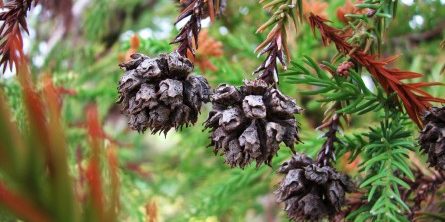THE LEAFLET

Tree of the Month: Japanese Cryptomeria
The Japanese Cryptomeria (Cryptomeria; known in Japan as Sugi – 杉) is a unique specimen.
A conifer, it is the only tree in the cypress genus Cryptomeria and it is entirely unrelated to (but often mistaken for) the true cedars of the Cedrus family, carrying with it an English moniker of “Japanese cedar.” Its name, however, actually means “hidden parts,” which is also misleading, because it is hardly a tree that flies under the radar in its native Japan. It is the national tree of Japan, but also one of the country’s most prized species. Commonly planted around temples and shrines, its ornamental aesthetic is incredible – but it isn’t a species just for show. It is grown extensively for its wood quality – strong, sturdy and solid – not only in Japan, but in massive quantities (and for hundreds of years) in China as well.
This is unique in that it has been grown for so long in China that it was often thought to be native there, even having its own distinct cultivars for different uses – however, genetic analysis has shown that that extensive population (some of which is nearly 1,000 years old) originates from the initial Japanese species. The Cryptomeria is also planted widely across Europe, North America and eastern India as an ornamental, and typically reaches around 50-60’ in height (but can and has reached upwards of 150’ in its native Japan). Few, if any, trees planted in the District are easily confused with this rarity – it has been compared visually to the great western sequoias, but details big and small make it apparent that they are unrelated. The Cryptomerias grow easily and quickly in the right conditions, taking to deep, rich and acidic soil more preferably and enjoying full sunlight (but needing shelter from high winds). They take up a slightly pyramidal shape with a singular, stout trunk and erect, wide spread branching – and best of all, deliciously fragrant foliage.
Impacted by few pests or diseases, one unique phenomenon often throws many passersby for a loop – the trees’ needles take on a bronzy or brown coloring in the winter (particularly in windy conditions) and can give the impression of loss of life. But it’s tough looking this good all year round – and considering how aesthetically appealing this species is, it is easy to characterize the Japanese Cryptomeria as stately and graceful, a natural pair for the country from which is originates.
The species’ contribution to the urban canopy is a special one – the role of a standout amongst a cast of familiar characters, a pop of beautiful diversity in a city of consistent natives. But the best way to describe its urban role is actually from a well-established, century-old story stemming from Charles Sprague Sargent’s 1893 “Notes on the Forest Flora of Japan:”
A daimyō, or feudal lord, too poor to donate a stone lantern at the funeral of a shogun (military general), requested instead to be allowed to plant an avenue of Sugi, “that future visitors might be protected from the heat of the sun.” The plea was accepted and the Nikkō Tōshō-gū (Shinto shrine) continues to this day to be characterized by the incredible forest of Japanese Cryptomeria that engulfs it.